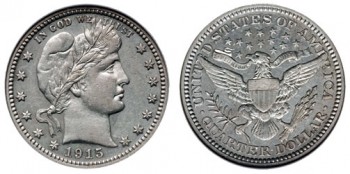Silver Barber Quarters were issued by the United States Mint from 1892-1916. The quarter-dollars take their name from the person who designed both their obverse and reverse, Charles E. Barber, the chief engraver of the United States Mint from 1880 to 1918.
The U.S. Mint struck each Barber Quarter with 0.1808 ounces of silver (melt value information can be found using the calculator in the right column). Each 90% silver coin has a total weight of 6.25 grams. Shown on the obverse is a bust of the mythical figure of Liberty while the reverse showcases the image of a heraldic eagle.
Previous to the release of Barber Quarters in 1892, the U.S. Mint struck the Seated Liberty Quarter which debuted in 1838. In fact, the fifty plus year run of the Seated Liberty was one of the main factors behind the introduction of the new release.
Historical Barber Quarter Silver Coin Melt Values
Wanting to bring about a feeling of art in American coinage, U.S. Mint director James P. Kimball pushed for Congressional legislation permitting a change in designs on minor silver coins of the day. Fulfilling that request, Congress passed legislation allowing modifications every twenty-five years without the need for further Congressional intervention.
Following the passage of the new law, then U.S. Mint director Edward O. Leech appointed a four-panel committee charged with finding designs. One of the members of that committee was the Mint’s chief engraver Charles E. Barber. Whether he blocked other design proposals on purpose may never be known, as none passed the committee. Instead, Barber was charged with creating the new imagery.
Barber created an obverse image showcasing the bust of Liberty, facing right. Liberty is seen wearing a Phrygian cap meant to symbolize freedom and liberty. Thirteen stars are shown surrounding Liberty which represents the original thirteen American colonies. This same design was also used on the dime and the half dollar introduced that same year. Obverse inscriptions include “IN GOD WE TRUST” and the year of minting.
The reverse of the quarter was different from the dime but was appeared on the half dollar. It showcased a heraldic eagle also surrounded by thirteen stars. Shown on the reverse were the inscriptions of “UNITED STATES OF AMERICA” and “QUARTER DOLLAR.”
Due to the same law which allowed the Barber Quarter to be struck, twenty-five years after its first appearance, the Barber Quarter would later be replaced by the Standing Liberty Quarter Dollar designed by sculptor Hermon Atkins MacNeil.
Barber Quarters tend to be very collectible with complete sets attainable at reasonable prices (with the exception of three rare issues). The coins also have an intrinsic melt value owed to the 0.1808 ounces of silver in each. Thus, even if collectors are not interested in a specific coin because of its poor quality, they can still be relatively valuable.

